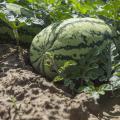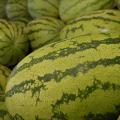Should I trellis cucumbers?
Trellising cucumbers has several advantages. The fruit are straight, have no ground spot, and are not subject to belly rot. Belly rot is the most limiting factor in cucumber production in Mississippi. Preliminary trials at the Beaumont station show trellising may also extend the harvest season. The disadvantages of trellising have to do with the expense of erecting and maintaining the trellis.
News
RAYMOND, Miss. -- Commercial vegetable growers have a new mobile-based resource to help them manage pests and diseases in their crops. The MyIPM for Vegetables app is the latest in the MyIPM app series. MyIPM for Vegetables currently offers resources for tomatoes and cucurbits, which includes cucumbers, pumpkins, squash and watermelons.
RAYMOND, Miss. -- Harvest is in full swing for Mississippi watermelon producers as rains ramp up, increasing the likelihood of disease and ruined melons.
RAYMOND, Miss. -- Watermelon production in Mississippi is off to a good start in the early days of harvest season. “Right now, everything looks really good,” said Heath Steede, Mississippi State University Extension agent in George County. “They’re pulling them pretty hot and heavy right now.”




